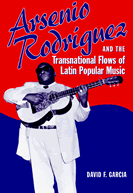
Arsenio Rodríguez and the Transanational Flows of Latin Popular Music
By David F. García
Temple University Press
1-59213-386-X
An oddity in the Blue Note catalog, Sabu (Martinez)’s Palo Congo LP is a strictly Afro-Cuban percussion-oriented session, without any jazz soloists, but featuring Arsenio Rodríguez on tres (a Cuban six-string guitar) and vocals. While jazz listeners might know Rodríguez best from this session, his influence on Latin music, particularly the development of mambo and salsa styles is profound, as García explains in Arsenio Rodríguez.
Blinded as a young boy as the result of an accident, Arsenio Rodríguez would find music to be an avenue of advancement for a Cuban of African descent. Rodriguez developed a wide following for his son montuno style with its dense poly-rhythms. He attained significant popularity in Cuba before the revolution through his live performances on Radio Mil Diez, a station then owned by the Communist Party. Although he was pressured to join the party, Rodríguez refused, protesting: “No, no, no. I don’t belong to any party. I play for both the conservatives and the liberals. And if they’d pay me I’d play in a cemetery. My [politics] is music.” (p. 28) However, García argues his continuing aversion to politics may have dampened enthusiasm for Rodríguez among the post-revolutionary Cuban immigrants in America.
Throughout his American career Rodríguez had repeated dust-ups with the musician’s union. One instance in 1953 involved defiance of Local 802 prohibitions against foreign orchestras playing for dancing, as opposed to strictly listening pleasure (which was grudgingly allowed), when the visiting Conjunto Casino played the Tropicana Club in the South Bronx. According to García: “Audience members, however, did dance, and after Conjunto Casino’s set was finished Arsenio’s musicians began to take the stage when [union enforcer] Ugarte ordered all union members off the stage.” Rodríguez was quoted as responding: “He, as a Cuban, will play even if they terminated his membership.” (p. 29) He was fined for his defiance of Ugarte’s authority. In his final days, union authority would actually prevent the recording of his last LP when “recording officials from Los Angeles’ Musician’s Union (Local 47) canceled the session because Arsenio had not paid his union dues.” (p. 115) He would pass away a few weeks later.
When emphasizing Rodríguez’s African ancestry García makes much of “revisionist” memories of Cuba on the part of political exiles, suggesting there was in fact much racial inequality before the revolution. Surely, Rodríguez did face discrimination, most likely acerbated by his blindness. However, García has little to say about the effects of Castro’s regime, although he does mention late in the book the Communists’ decision to ban or “discontinue black social clubs after 1959.” (p. 145) Such clubs would later be celebrated in the Buena Vista Social Club film and CDs.
While Rodríguez never attained the commercial success in America he had in Cuba, his influence on the mambo of Tito Puente and Perez Prado, as well as the salsa of Larry Harlow and Ray Barretto is clear. His style would inform their playing and his tunes would become part of their repertoire.
García’s book is strongest when approaching the subject from an ethnomusicologist’s perspective. His analysis of Rodríguez’s son montuno style will help refocus critical attention on a neglected figure in Afro-Cuban musical history. As a biographer, García is less successful. For instance, only passing mention is made of Rodríguez’s conversation from Santeria, becoming a Jehovah’s Witness—surely an incident of great importance in Rodríguez’s life. If lacking a biographer’s flare for drama, García is at least a convincing advocate, building an effective case for his subject’s place in music history.